Good Neighbours:
Volunteer And Social Impact Platform
Tools
- Miro
- Adobe
- Trello
Team
- 1 UX designer
My Role
- UX Design
- UX Research
Timeline
- Overall 12+ Weeks
The Volunteer and Social Impact Platform
The Volunteer and Social Impact Platform is a transformative project that leverages technology to streamline volunteerism and social impact initiatives. It addresses key challenges, aligns with current trends, and serves as a comprehensive platform for connecting volunteers and organizations. The platform enhances accessibility and effectiveness of volunteerism, benefiting various stakeholders and envisioning a society where technology fosters active community contribution and positive social change.

Methodology
The “Good Neighbours” project uses Stanford Design Thinking to create a Volunteer and Social Impact Platform. This user-centric approach involves understanding user needs, empathizing with their experiences, and iteratively prototyping and testing solutions. Despite the time and resource-intensive nature of this method, it allows for continuous improvement based on user feedback. The project management utilizes tools like Trello and Miro for planning and data organization. Initial user surveys and interviews revealed key insights into volunteer behaviors, preferences, and challenges, which guide the platform’s design to foster community involvement and positive social impact.

Affinity Mapping
Empathy mapping is a valuable technique for understanding users’ emotions, motivations, and perspectives in your Volunteer and Social Impact Platform project. It ensures solutions address both the actual issues and the individuals experiencing them by considering users’ goals and challenges. The map includes sections like “What they do and need to do,” “See,” “Hear,” “Say and Do,” “Pain,” and “Gain.” Two characters, representing participants and organizers, were created to understand their pains, gains, and other perspectives.
Empathy Map Analysis – Participant
- Need a safe, dedicated website for sharing experiences without trust issues.
- Ability to track progress and document achievements.
- Facilitate communication with organizers and other volunteers.
- Enable experience sharing on social media.
- Easy scheduling for volunteering activities.
- Provide reviews and ratings.
Empathy Map Analysis – Organizer
- Provide guidance and instructions to volunteers via calls and descriptions.
- Maintain long-term contact with participants.
- Track each participant’s progress.
- Reimburse participant expenses.
- Recognize participant milestones with small tokens of appreciation.
- Organize everything to reduce problems.
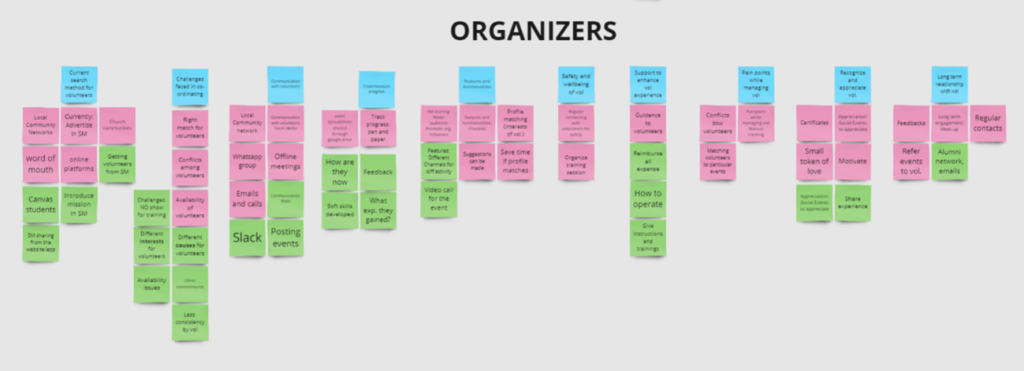

Empathy Mapping
Empathy mapping helps project teams and designers understand users’ emotions, motivations, and perspectives. This technique ensures solutions address both the actual issues and the individuals experiencing them by considering users’ goals and challenges. The map is divided into sections like “What they do and need to do,” “See,” “Hear,” “Say and Do,” “Pain,” and “Gain.” Two characters representing participants and organizers were created to understand their pains, gains, and other perspectives.
Empathy Map Analysis – Participant
- Need a safe, dedicated website for sharing experiences.
- Ability to track progress and document achievements.
- Facilitate communication with organizers and volunteers.
- Enable experience sharing on social media.
- Easy scheduling for volunteering activities.
- Provide reviews and ratings.
Empathy Map Analysis – Organizer
- Provide guidance and instructions to volunteers.
- Maintain long-term contact with participants.
- Track each participant’s progress.
- Reimburse participant expenses.
- Recognize participant milestones with tokens of appreciation.
- Organize everything to reduce problems.

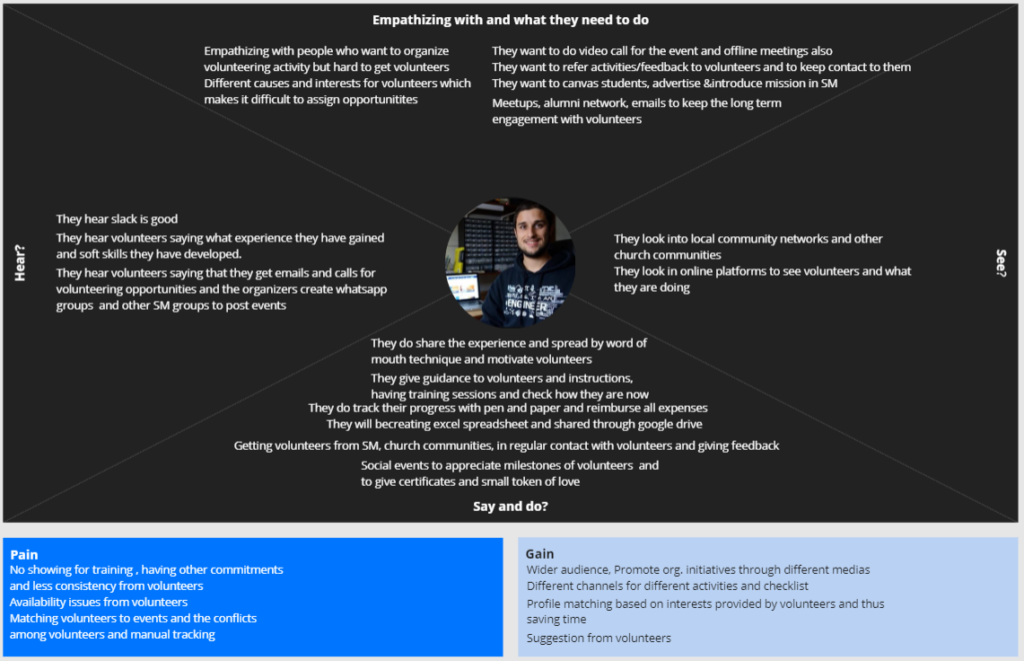
Persona
The “Good Neighbours” project uses a systematic approach to develop a Volunteer and Social Impact Platform. It employs affinity mapping and empathy mapping to understand user needs and emotions, guiding feature development. User personas and customer journey maps inform design decisions. Ideation techniques foster innovative solutions, evaluated by the NUF test. Competitive analysis provides industry insights. Prototyping refines the platform’s design, adhering to key design principles. The testing phase, including 5-Act Interviews and the System Usability Scale, ensures the platform’s effectiveness. The result is a user-friendly platform with a high usability score, ready to facilitate meaningful volunteer engagement and positive social impact.
Persona Learnings – Participant
- Likes to participate in events without sharing details
- Participant should get to know if there is any change in the schedule
- Need data protection
- Need verified organizer profiles in the website
Persona Learnings – Organizer
- Wants to promote organization activities, so that wider audience needed
- Wants to have a long term relationship with volunteers
- Wants to create a network and share events with volunteers
- Want separate channel for each activity
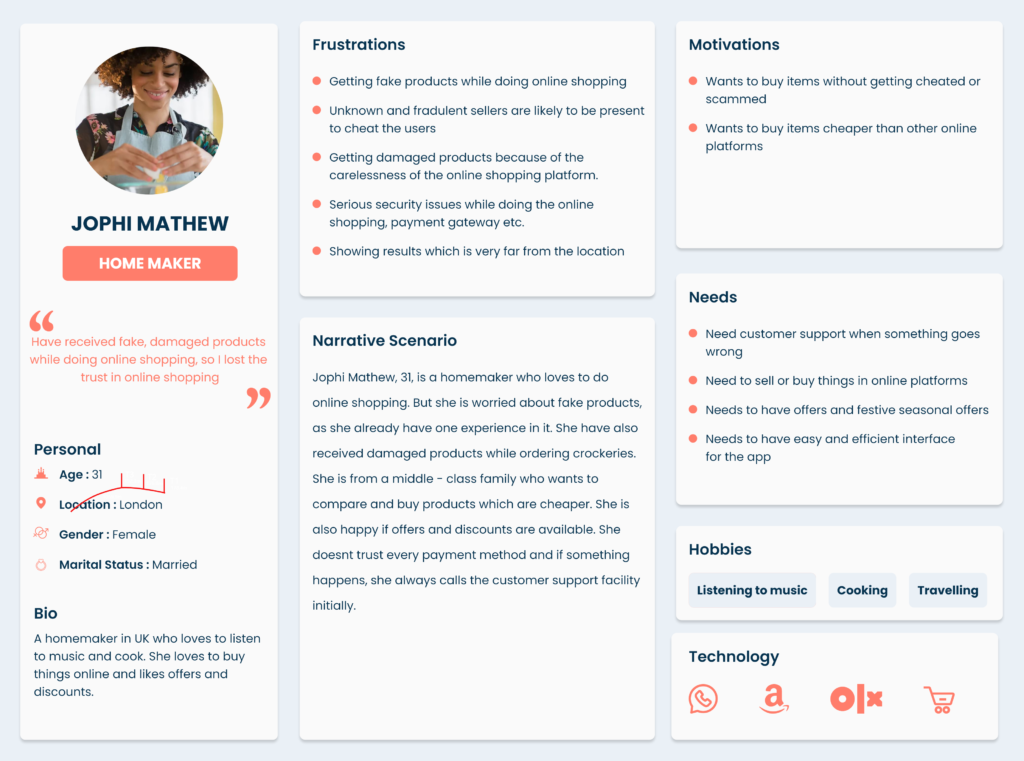
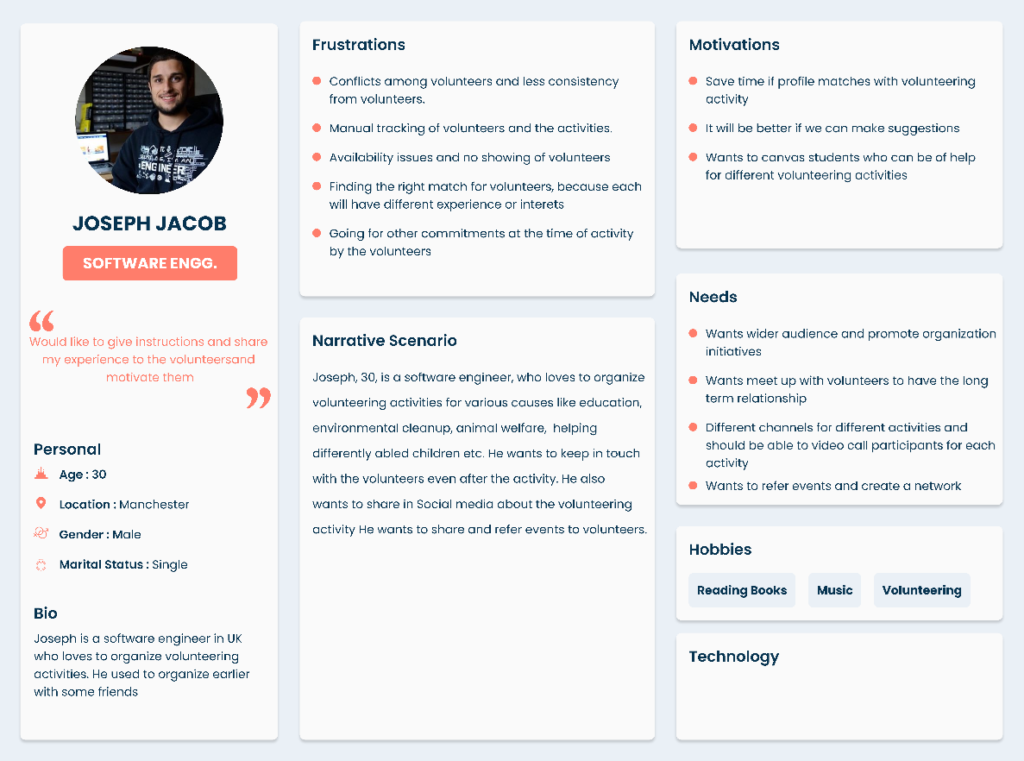
Customer Journey
We created a customer journey map to build a better understanding of how customers find and interact with the service and to discover opportunities for improvement. The map revealed many user problems and opportunities at the consideration and loyalty stages of the customer journey. Therefore, we paid special attention to these stages during the design process.
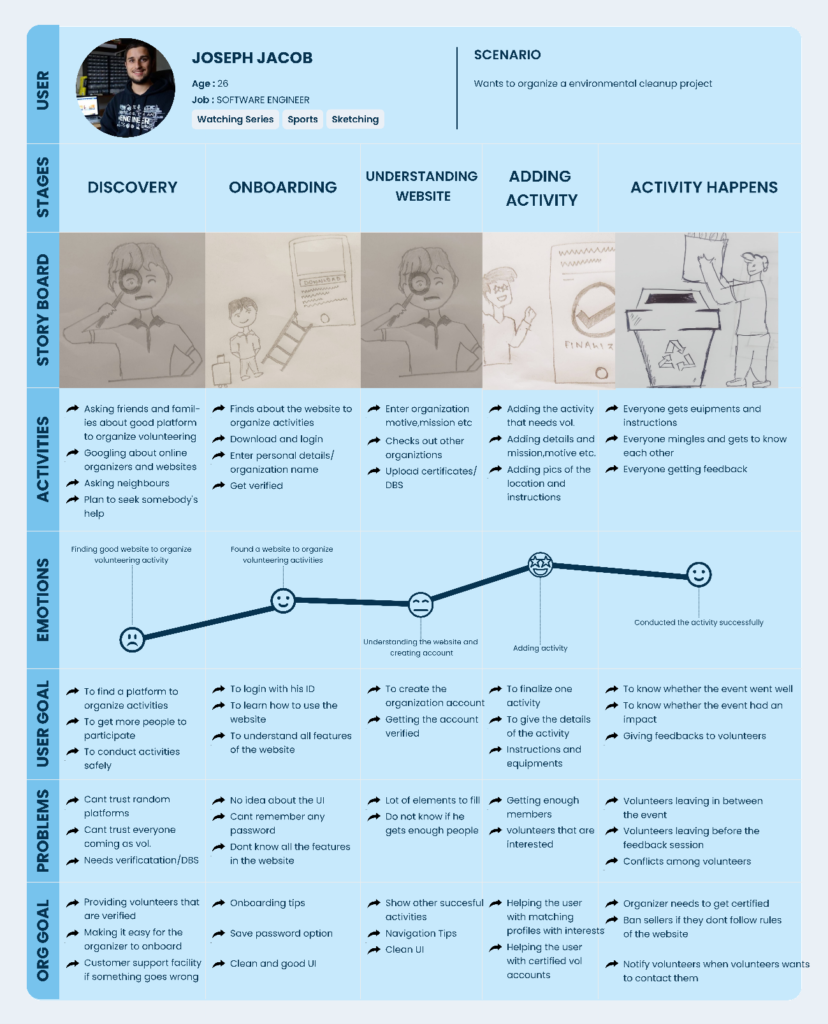
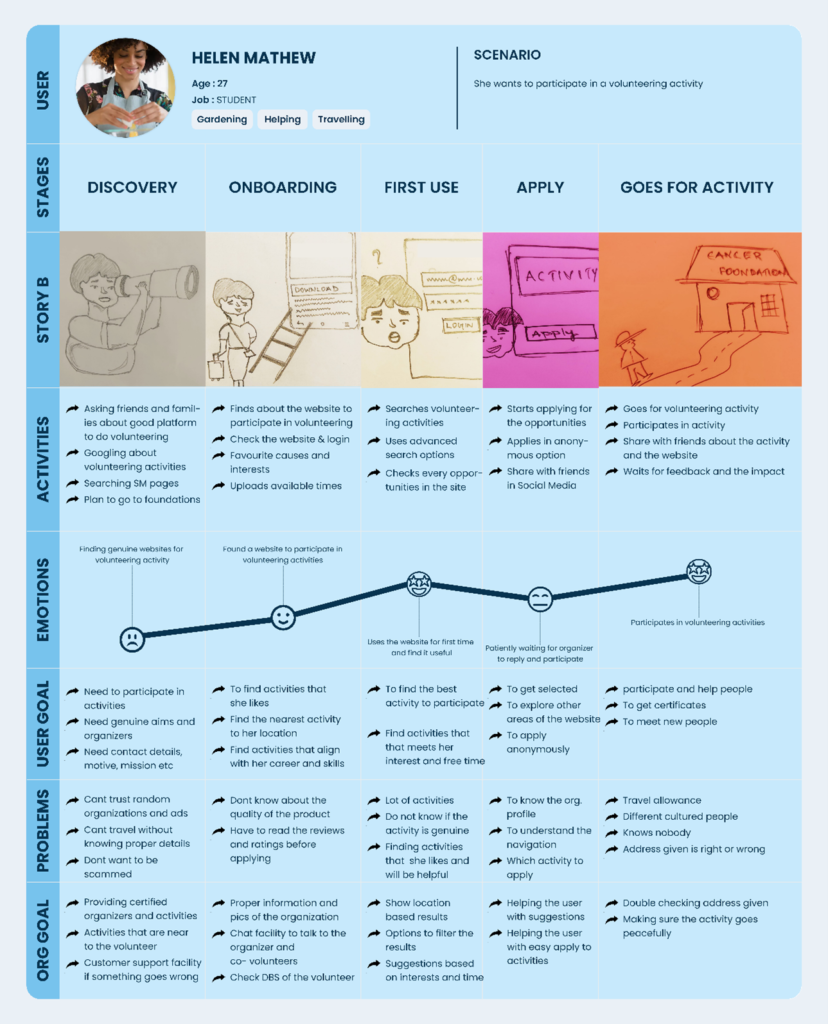
POV Statements
To understand and empathize with users’ perspectives. These statements are written from the user’s point of view and describe their thoughts, feelings, and actions in a particular scenario. can better understand their users’ needs, motivations, and pain points, which can inform the design of products and services that are more user-centric and effective.
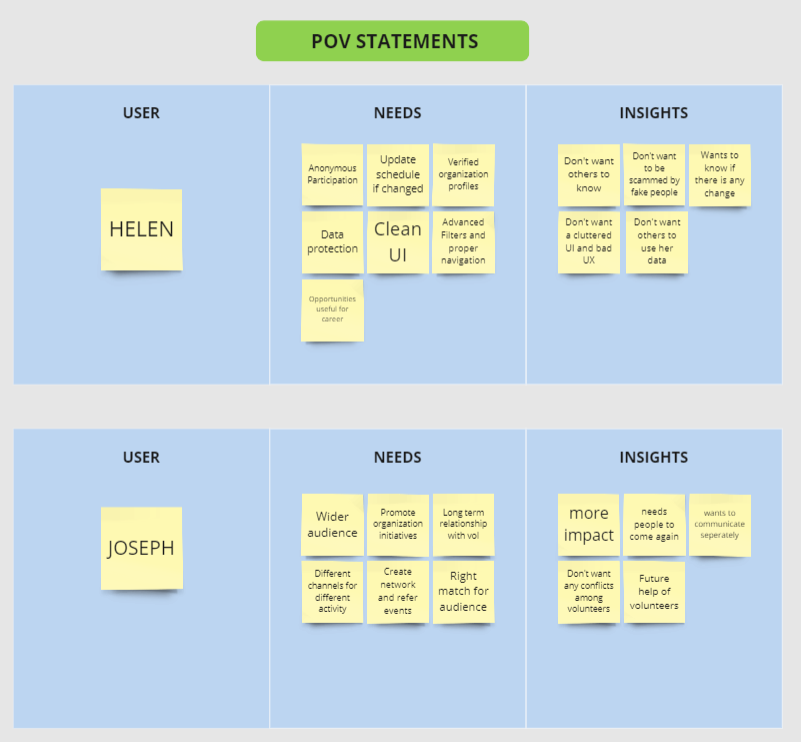
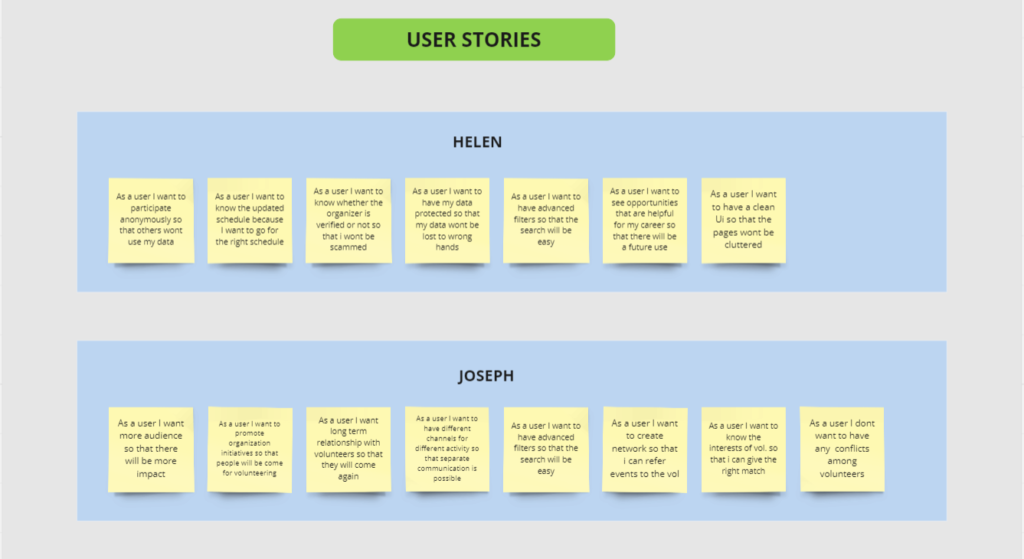
User Stories
User stories are a technique to succinctly and formally express the demands and objectives of users. User stories’ main objective is to assist design teams in comprehending the viewpoint of the user and producing a user-centred design.
Ideation
How Might We
“How Might We” (HMW) questions help outline design challenges and brainstorm solutions in the Volunteer and Social Impact Platform project. These questions encourage creative thinking and problem-solving.
HMW – Participant
– How might we create an effective search method for updated results?
– How might we match volunteering opportunities with career goals?
– How might we provide local volunteering opportunities?
– How might we enable anonymous participation?
– How might we ensure data security?
– How might we design a website that attracts more volunteers?
HMW – Organizer
– How might we promote organizational initiatives effectively?
– How might we build long-term relationships with volunteers?
– How might we create channels for different activities?
– How might we attract a larger audience and increase impact?
– How might we develop an advanced search technique with filters?
– How might we maintain a conflict-free environment for volunteers?
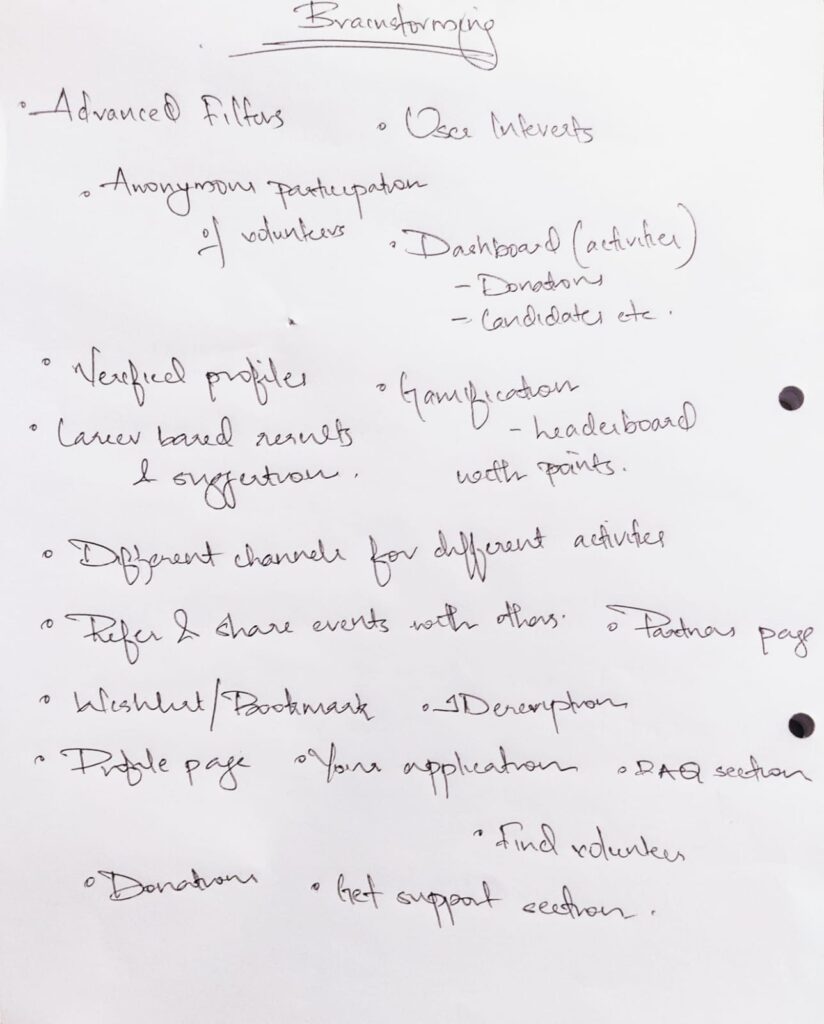
Brainstorming
Brainstorming session was done with a friend who has organized volunteer activities to get large number of creative and diverse ideas. It helped to get an idea of what all features must be there in the website which will be useful for both participant and organizer.
Rapid Idea Generation
The rapid idea generation was used to create ideas with one HMW. Here the page is divided into eight sections with the tags Google, Apple, Airbnb, Meet up etc. and how these companies will be solving a particular issue is written or drawn. From that 3 ideas will be taken.
Ideas Taken – 1
- Simple search bar with one or two extra options
- Search bar with filters
- Search bar with separate filter
Ideas Taken – 2
- Doodle and Animation
- Organize a group and meet regularly
- Gamification and other stats

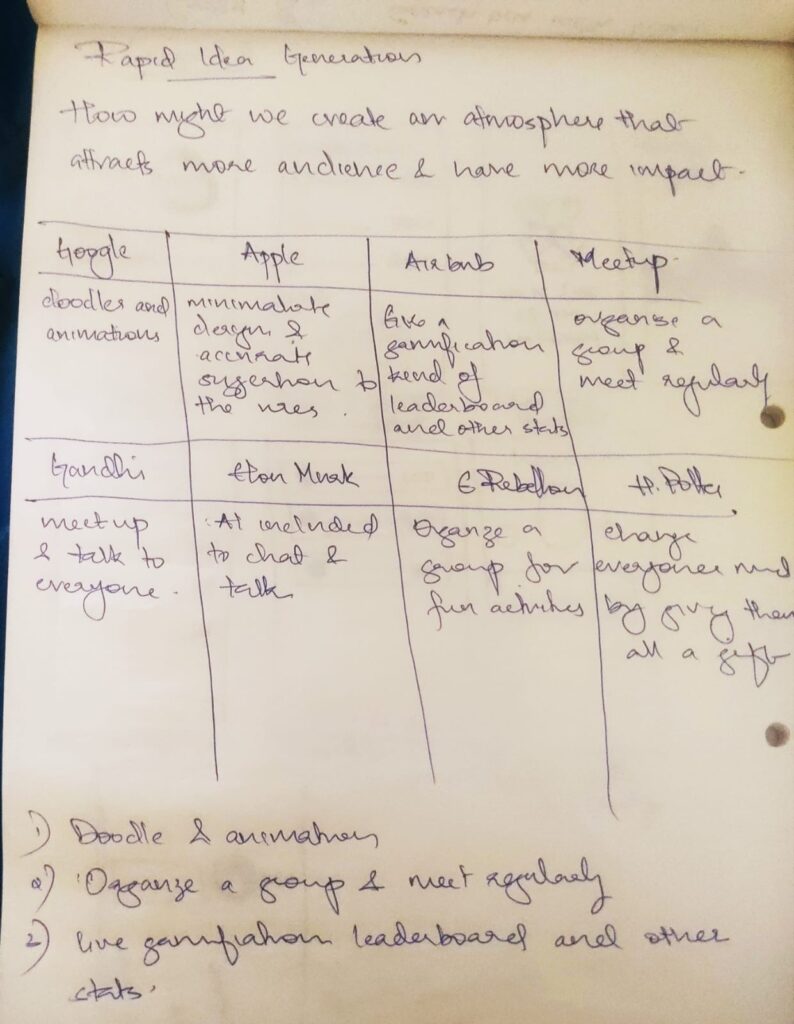
Crazy 8
In this section, the idea that we took is represented in 8 different ways. Therefore we get to know the possible ways it can be done. He the ideas took were search bar with filters and gamification. So the ideas were drawn in 8 different ways
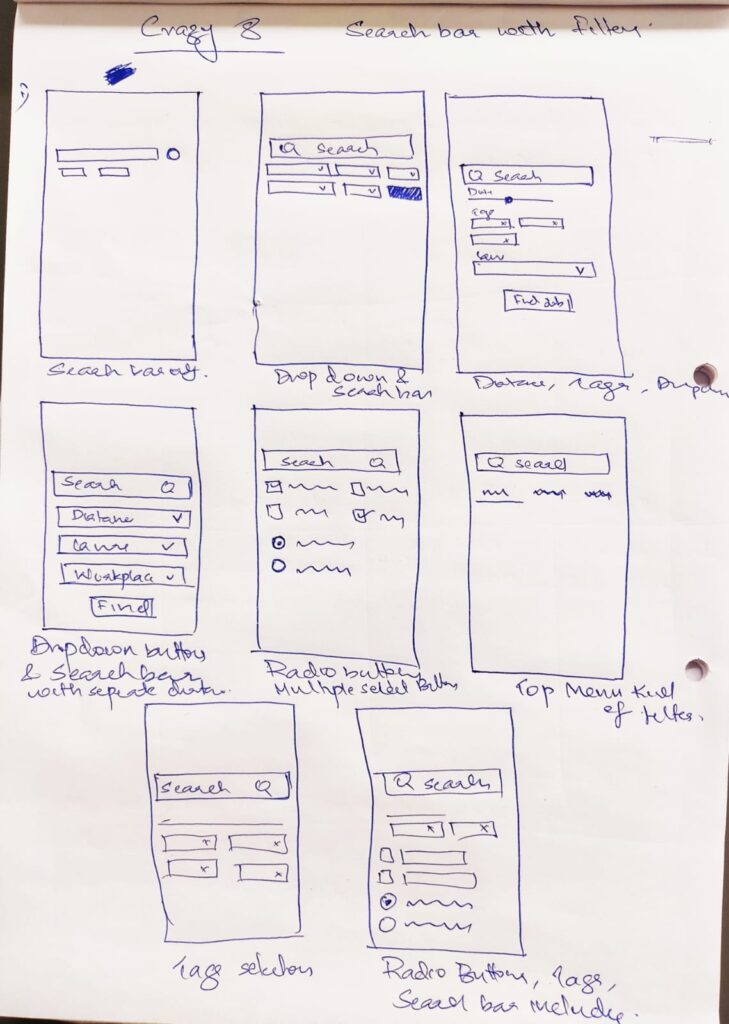

NUF Test
An evaluation framework for determining the viability of a suggested design solution is the Needful Useful Feasible (NUF) test. The purpose of the NUF test is to determine whether a design concept satisfies three important requirements:
Needful: Does the design actually address a user need or solve a real problem?
Useful: Will people find the design to be practical and worthwhile?
Feasible: Can the concept really be put into practice given the limitations of time, money, and technology?

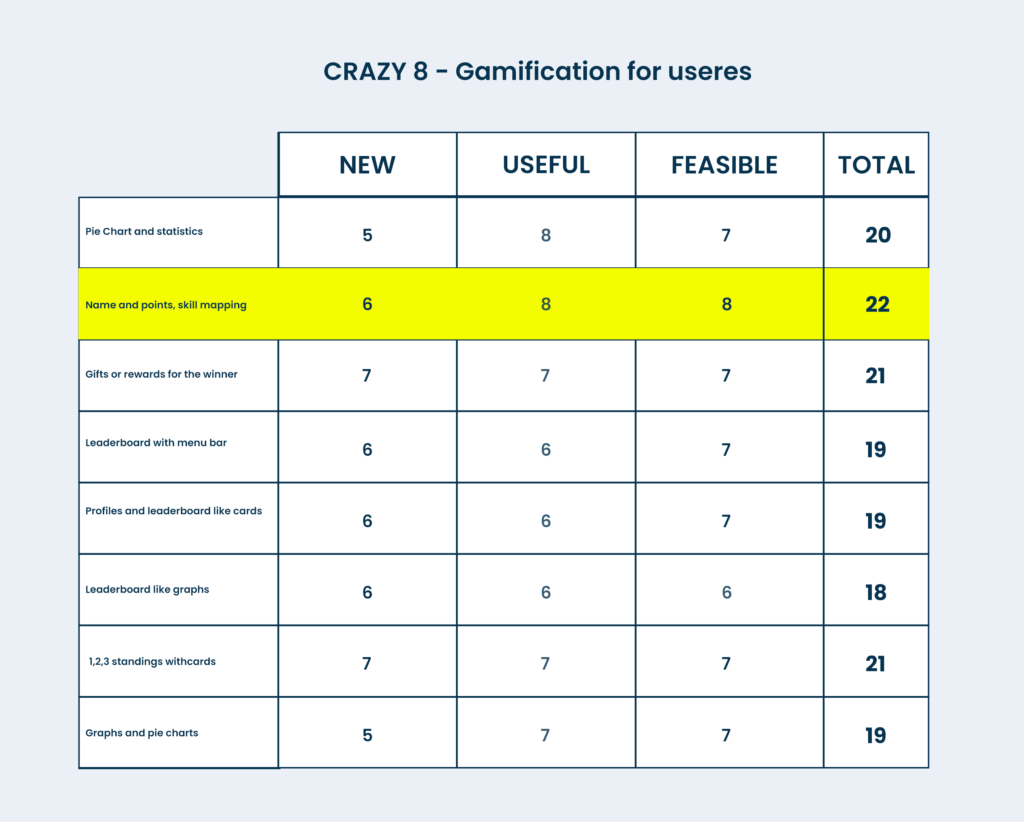
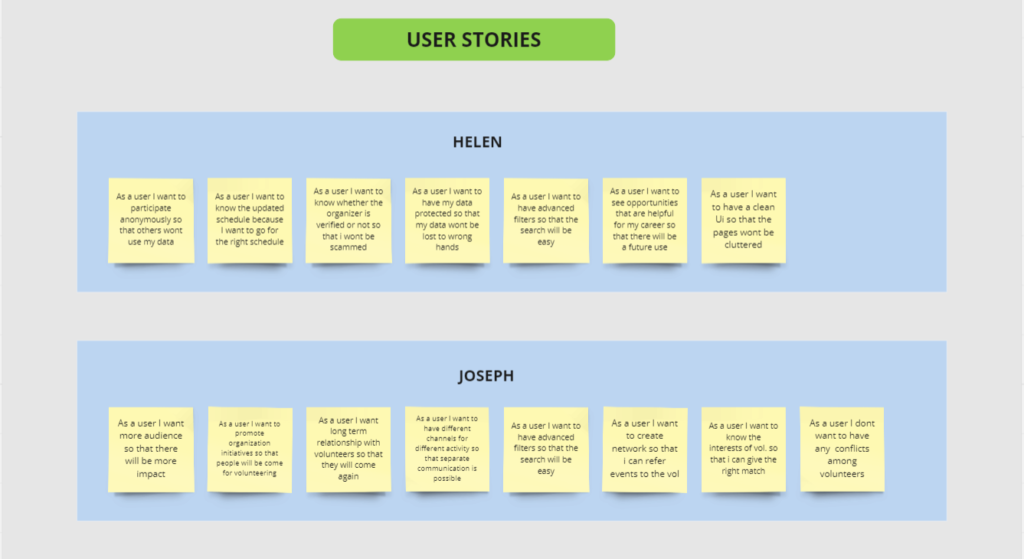
Competitive Analysis
Finding competitors in your business and learning about their various marketing methods is the process of conducting a competitor analysis, also known as a competitive analysis. You can compare this data to those of your competitors to determine your products advantages and disadvantages.
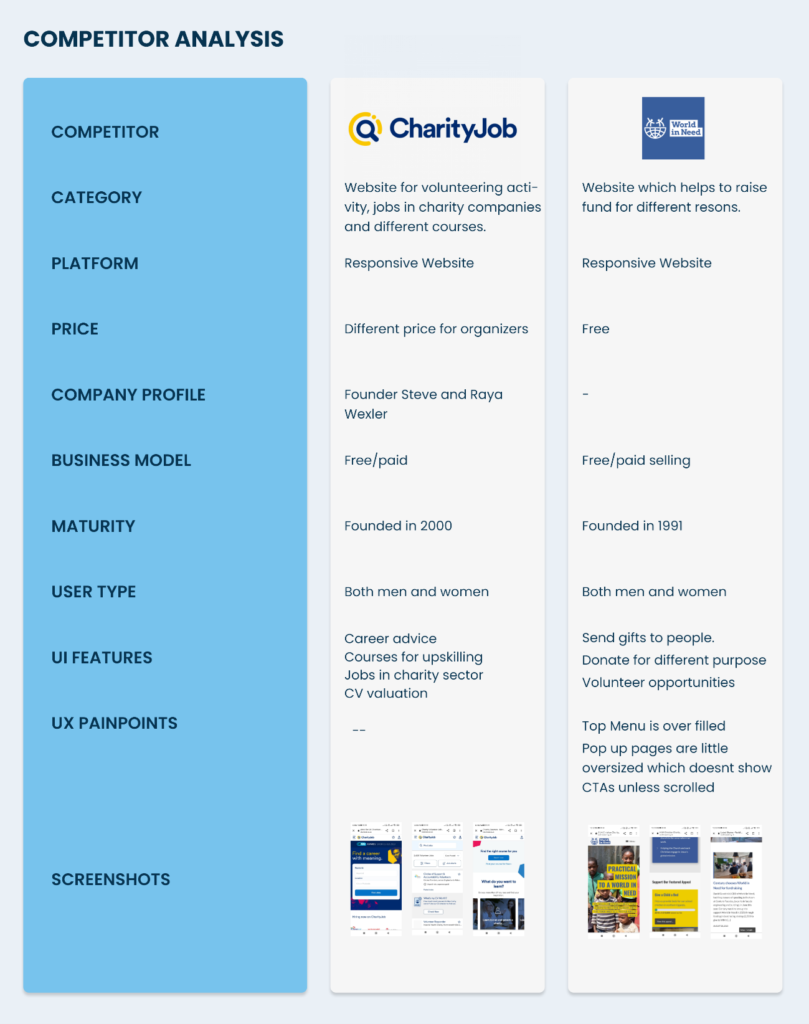
Wireframes
Using Adobe XD, I translated my first sketches into low-fidelity wireframes. Wire flows were also done at this stage which later helped to do the Hi-fi prototype After completing wireframes I moved on to creating high-fidelity prototypes.
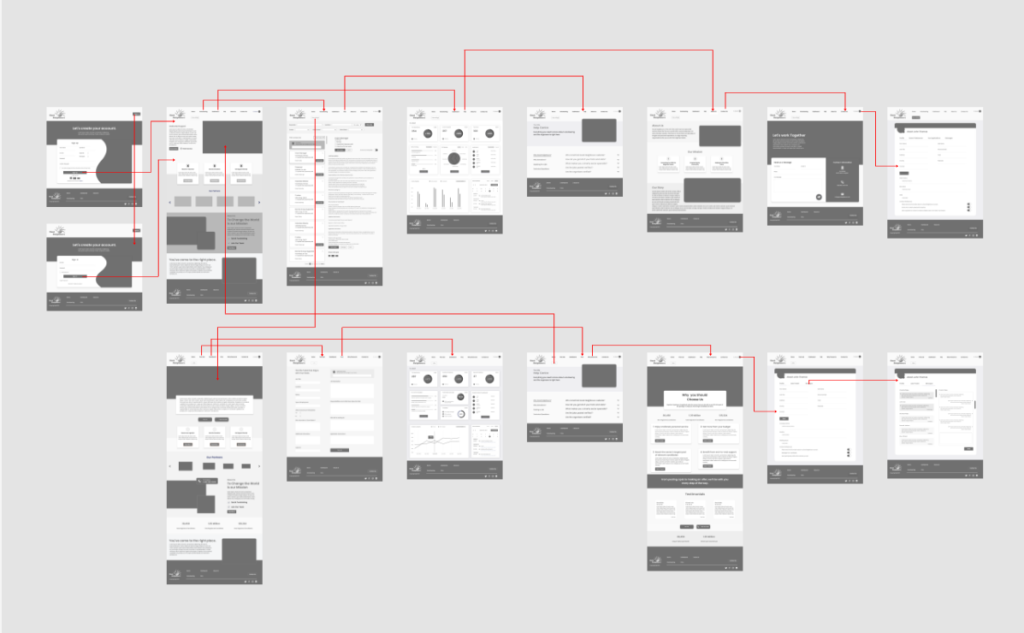
Hi-Fi Prototype
The hi-fi prototype was created along with mobile screen in Adobe XD. All the feedbacks were in mind while designing the prototype. The colours from the mood board were used. All the features from the user research were carefully considered. Keeping the pain points, frustration were considered while doing the designing.
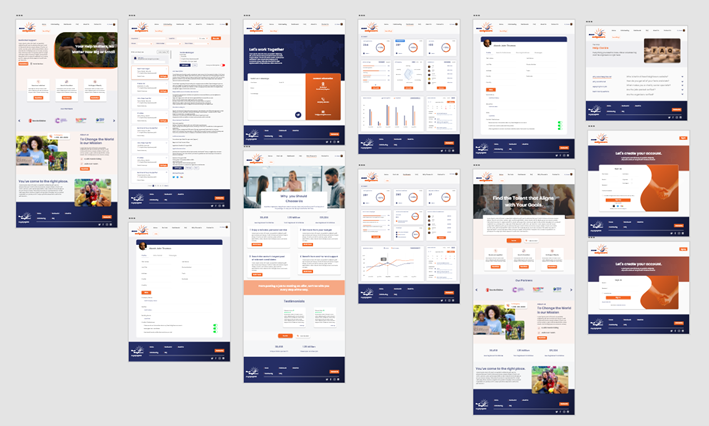
Discussion
The prototype is highly valuable, based on extensive user feedback from diverse backgrounds. Surveys and interviews ensured the final product meets user needs. The platform’s success depends on effective adoption and sustained user engagement.
The project modernizes volunteer engagement and social impact coordination, focusing on user needs to foster meaningful community involvement. Key strengths include innovative features like event listings, progress tracking, and social sharing. Challenges include integrating competitor features, refining the design, and testing the organizer section.
